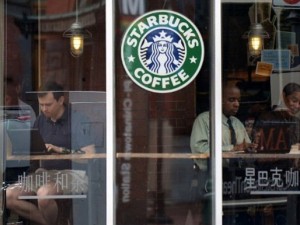MUMBAI – Starbucks is betting on big returns as it seeks to lure an expanding legion of coffee lovers in India – primarily a tea-drinking nation where lifestyle changes have spawned a booming market for cafes.
After eyeing the Indian market for years, the world’s largest coffee chain is planning its foray into the country later this year, with an initial $78 million investment to tap the country’s fast-growing appetite for the drink.
“Coffee has changed from being a traditional beverage, consumed mainly in south India, to a mainstream beverage with a national presence,” said Starbucks’ China and Asia-Pacific president John Culver.
“Given the size of the Indian economy, the growth of cafe culture and the rising spending power, India will be a very large market over the long term,” he told AFP in an emailed interview.
In a traditionally tea-drinking nation, India’s annual per capita coffee consumption of 82 grams (three ounces) is far below that of 6.79 kilograms (15 pounds) in Germany and 5.87 kg in Brazil, according to data from the International Coffee Organization.
But appetite for the bitter brew is growing amid an explosion of hip Western-style cafes catering to the country’s young consuming class who offer significant opportunities for investment with their rising disposable incomes.
In addition to the Indian-owned Cafe Coffee Day chain which dominates the market, foreign chains such as Britain’s Costa Coffee and American brand Coffee Bean and Tea Leaf are well-established in major Indian cities.
Along with its distinctive green-siren logo cups, Starbucks has vowed to tackle competition with “locally relevant” flavours as it adapts its menu to suit local tastebuds, following similar moves by other large chains in India.
US outlets such as Pizza Hut and McDonald’s have “Indianised” their offerings, selling Indian cottage cheese pizzas and spicy potato burgers to woo subcontinental consumers.
But analysts offer mixed forecasts for the Seattle-based brand which is teaming up with local player Tata Global Beverages to enter the Indian market.
“The Tatas have tea and coffee plantations, but little experience in operating coffee chains,” said P. Phani Sekhar, fund manager at Angel Broking, adding the alliance would have to “be streetsmart and nimble in decision-making”.
Sekhar said spiralling real-estate costs could also be problematic, with Indian cities such as Mumbai recording a sharp rise in property prices in recent years.
“The prohibitive costs… could affect store profitability and make (achieving) break even more challenging,” he said, adding that this could complicate Starbucks’ expansion plans into smaller Indian cities and towns.
It also remains to be seen whether Starbucks can bank on its brand appeal to charge higher prices in India’s inflation-prone economy.
With the India’s GDP growth having fallen to 6.5 percent in the year to March, after near double-digit expansion for much of the past decade, the growth in demand for premium coffee may be slower than hoped.
The key issue will therefore be of “penetration and network chains rather than of Indians drinking more coffee”, said Vijay Chugh, consumer and auto analyst with BNP Paribas Securities.
Starbucks had promised a simultaneous launch of stores in New Delhi and Mumbai by August-September, but Culver declined in the interview to give a specific date, saying only it would be “during the calendar year 2012”.
“I never really enjoyed their coffee,” said Arjun Rajagopal, a well-travelled executive with a global consultancy firm.
“It’s the cozy, informal ambience which is important, while meeting friends or for low-key business meetings to get work done,” he said.
